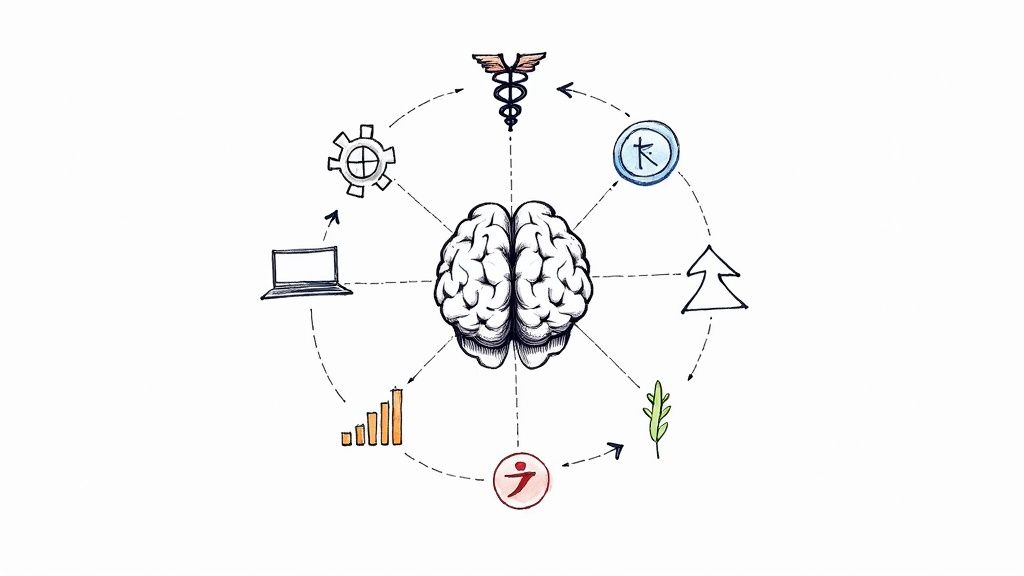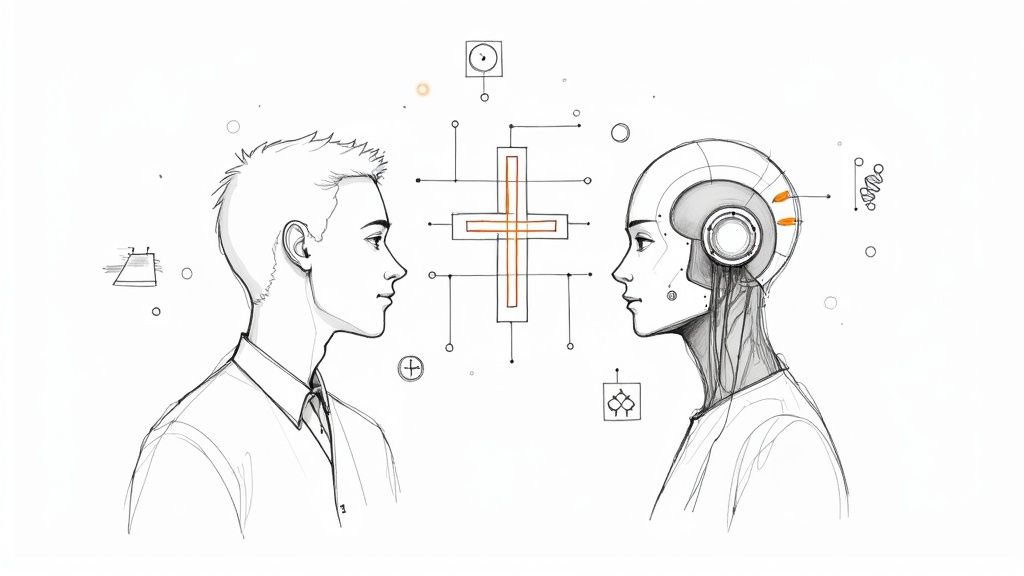Conversational AI in Healthcare Explained
Discover how conversational AI in healthcare is transforming patient care. This guide explains key applications, benefits, and implementation strategies.
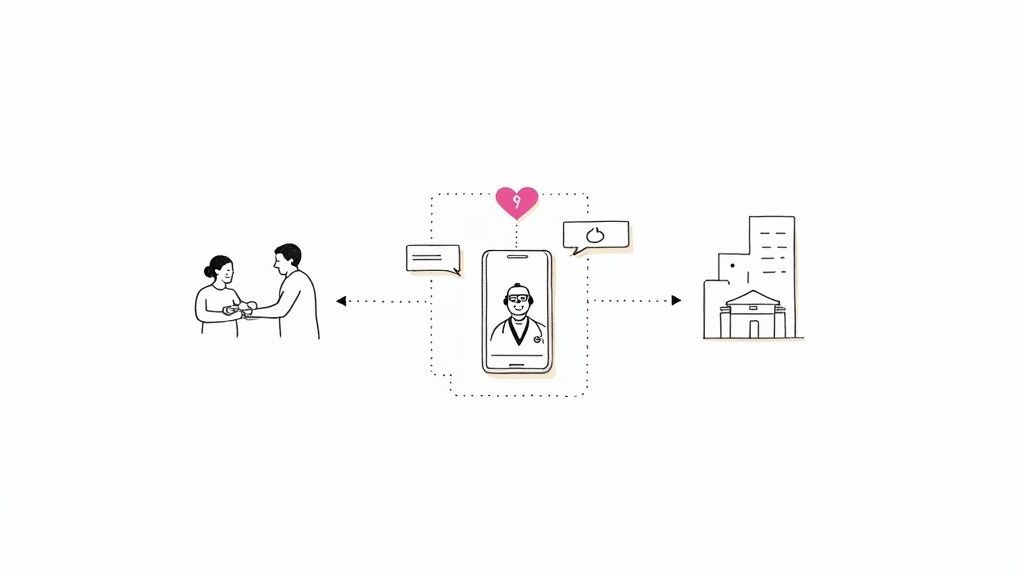
Think of conversational AI in healthcare as a smart, compassionate assistant who's on call 24/7. It's there to answer patient questions, schedule appointments, and gently guide them through their care journey. It essentially creates a new digital front door for your practice, supporting your human staff by fielding all those routine inquiries and administrative tasks.
This simple change frees up doctors, nurses, and front-desk staff to concentrate on what they do best: providing hands-on, critical patient care.
The New Digital Front Door in Healthcare
Imagine your clinic's front desk, but it never closes. It's always there, responds in a heartbeat, and can even communicate in multiple languages. That's the real power of conversational AI in healthcare. This isn't about replacing the human element; it's about amplifying it.
Healthcare systems are under constant pressure to deliver clear, timely information—everything from explaining prescription changes to walking a patient through post-visit instructions. Smart AI agents can step in and manage these repeatable conversations, like confirming appointments, answering basic insurance questions, or checking in after a procedure. By automating up to 30% of inbound requests, these AI assistants take the pressure off call centers and clinical teams.
Why It Matters Now
Patient demand is always climbing, but staff capacity rarely does. That mismatch is what leads to long hold times, frustrating phone tag, and a mountain of administrative work that gets in the way of providing great care. Conversational AI helps bridge that gap by taking on the repetitive communication that bogs everyone down.
The benefits are immediate and tangible:
- 24/7 Availability: Patients can get instant answers about clinic hours, prescription refills, or doctor availability—anytime, day or night.
- Reduced Administrative Load: Your front-desk team can finally break free from the constant ringing of the phone for scheduling and focus on the patients standing right in front of them.
- Improved Patient Experience: Getting quick, accessible support builds trust and eases anxiety, which is incredibly important for anyone navigating a new diagnosis or managing a chronic condition.
The infographic below really brings to life how this digital front door fits into the patient journey.
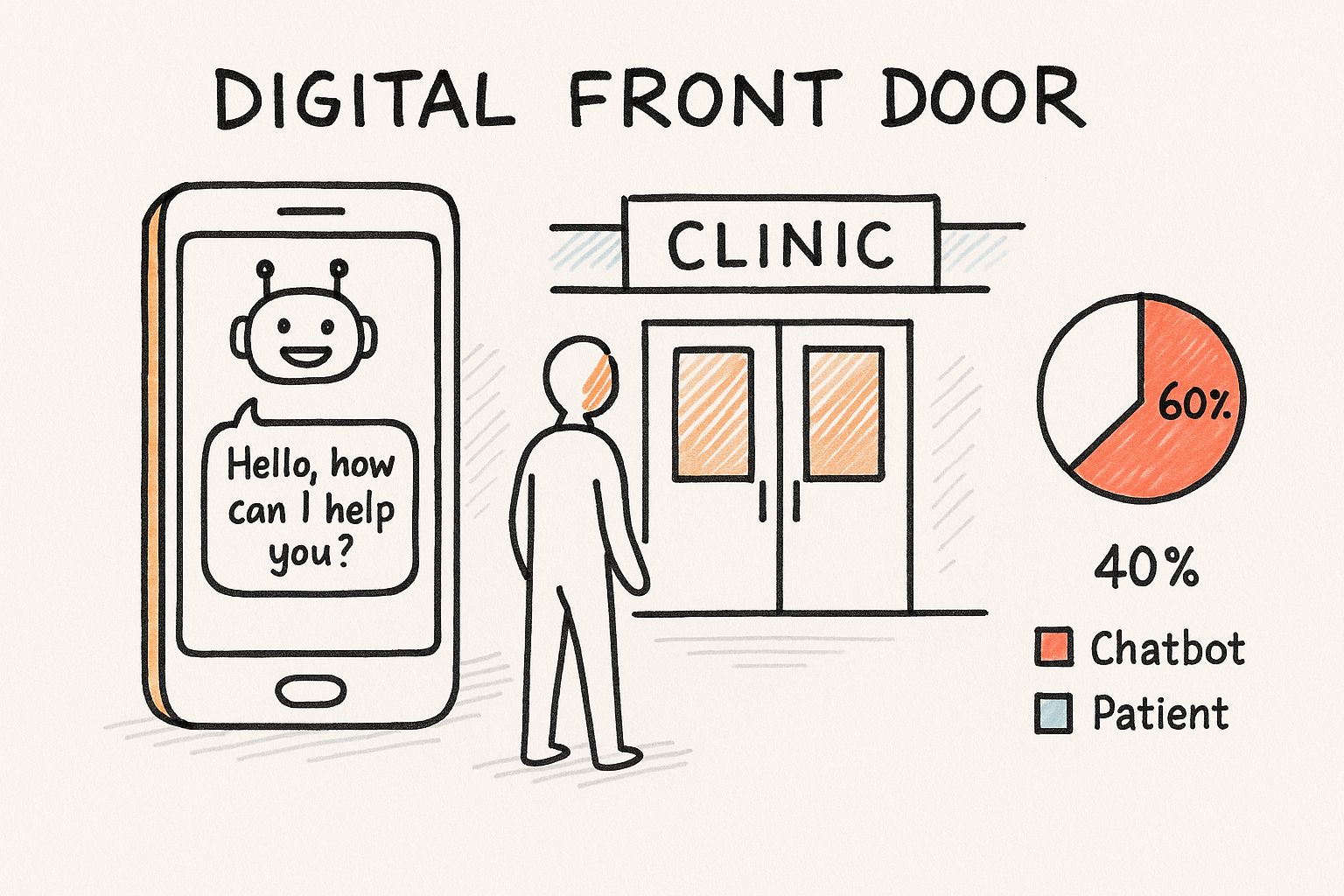
As you can see, the AI acts as the first point of contact, efficiently guiding patients before they even need to speak with a person. This smooths out the entire process from start to finish. Systems like a customizable AI assistant quickly become a fundamental part of operations, helping you deliver better care without adding risk.
How AI Reshapes the Day-to-Day of Healthcare
When we talk about conversational AI, it's easy to think of it as just another tech gadget. But in a healthcare setting, it's a fundamental shift in how things get done, directly impacting how organizations run from the inside out. By taking over the routine, yet absolutely critical, communication tasks, these AI systems lift a massive operational weight off the shoulders of both clinical and administrative staff.
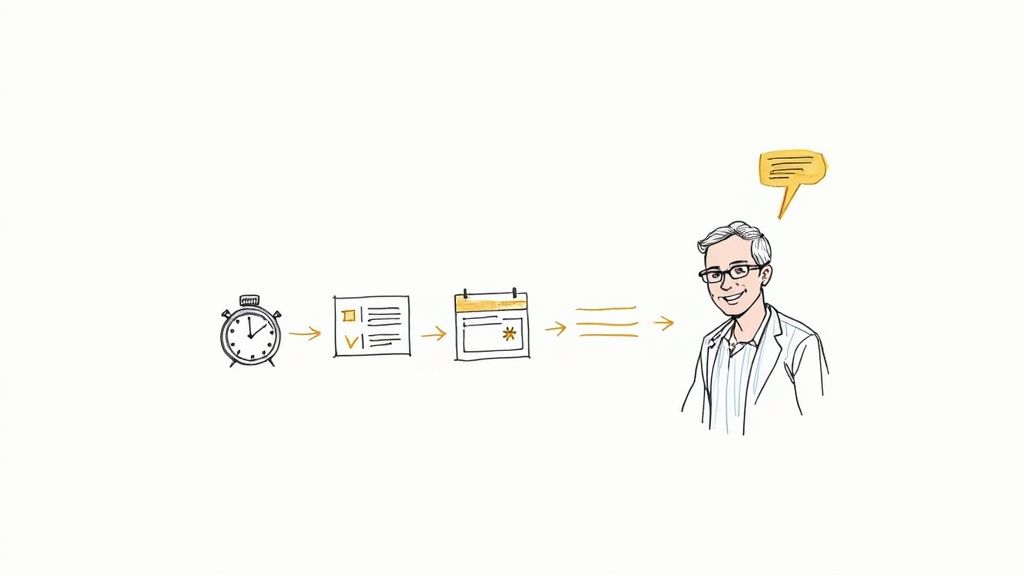
Think about the common headaches that lead to staff burnout and frustrated patients—the endless phone calls, the missed appointments. This is where the technology makes an immediate difference. For example, AI can handle the entire appointment lifecycle, from booking and rescheduling to sending out smart, automated reminders that have been proven to dramatically cut down on costly no-shows. This keeps schedules full and the clinic running smoothly.
The numbers really speak for themselves. A 2024 study from Microsoft and IDC revealed that nearly 80% of healthcare organizations are already using AI, and for good reason—they're seeing a return of over $3 for every $1 invested. This isn't some future trend; it's happening now, pushing the global AI healthcare market to around $27 billion in 2024, blowing past earlier predictions. You can discover more about the economic impact of healthcare AI and see just how significant this shift is.
Making Workflows Smarter for Patients and Staff
At its core, conversational AI in healthcare is about giving patients more control. By offering 24/7 self-service options, it lets them find answers, book appointments, or get pre-visit instructions whenever it suits them, not just during office hours. That kind of immediate, on-demand access is a huge trust-builder and makes for a much better patient experience.
While patients get more convenience, the staff gets something even more valuable: their time back. When an AI is fielding the constant stream of repetitive questions, your team is freed up to concentrate on the complex work that truly requires a human touch—like managing difficult patient cases or providing hands-on care. This is a central idea behind effective workflow automation.
To really see the difference, let’s compare the old way of doing things with an AI-powered approach. The table below lays it out clearly.
Traditional vs. AI-Powered Healthcare Workflows
Task Traditional Method Conversational AI Method
Appointment Scheduling
Manual phone calls, limited to office hours, potential for long hold times.
24/7 self-service booking, instant rescheduling, and automated confirmations.
Patient Reminders
Manual calls or generic text messages, staff time consumed by follow-ups.
Automated, personalized reminders sent via preferred channel, reducing no-shows.
Routine Inquiries
Staff members individually answer questions about hours, directions, or insurance.
Instant, accurate answers provided by an AI assistant, freeing up staff.
Data Collection
Patients fill out paper forms in the waiting room, requiring manual data entry.
Digital intake forms completed pre-visit, with data automatically synced to the EHR.
As you can see, the improvements go far beyond simple convenience. This shift doesn't just boost efficiency; it allows clinics and hospitals to handle more patients without burning out their teams. With the right AI strategy consulting, healthcare providers can grow sustainably while maintaining a high standard of care. Ultimately, the goal is to create a resilient system where technology works in harmony with human expertise, not in place of it.
Putting Conversational AI to Work in Clinical Settings
Beyond the front desk and scheduling, conversational AI is making real headway where it counts most: in the clinic itself. This is where the technology stops being just an efficiency tool and starts acting as a genuine partner in patient care, offering support that's both instant and tailored to the individual.
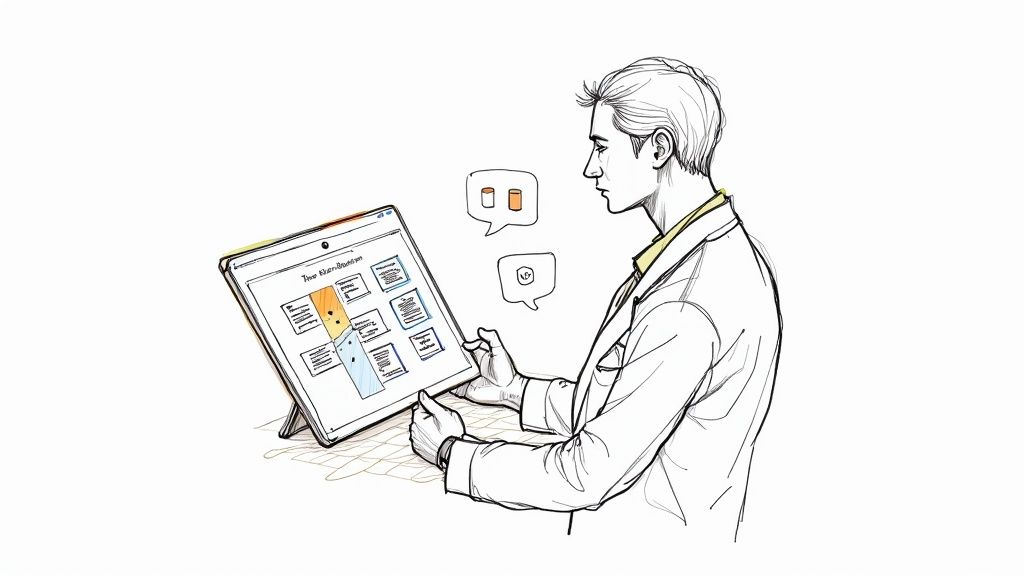
This evolution is backed by some serious market momentum. The conversational AI in healthcare space, valued at a substantial USD 13.68 billion in 2024, is expected to explode to USD 106.67 billion by 2033. That incredible growth isn't just about chatbots; it reflects a deep, industry-wide shift toward using AI for complex tasks like telemedicine and managing chronic conditions. To get the full picture, you can learn more about the global market forecast.
Guiding Patients with AI Symptom Checkers
One of the most immediate and impactful uses of AI is the symptom checker. Let's be honest, we've all fallen down the rabbit hole of searching symptoms online, a practice that often leads to more anxiety than answers. AI offers a much better alternative.
These tools don't just guess. They use clinically validated logic, asking a series of smart, structured questions to understand what's going on. Based on the answers, they can recommend the right next step—whether that's booking a doctor's visit, heading to urgent care, or simply managing symptoms at home. It’s triage, but available 24/7.
Supporting Mental Health and Medication Adherence
Conversational AI is also becoming a crucial, discreet entry point for mental health support. For someone who might be hesitant to speak with a person, a chatbot can offer a safe space to find resources, learn coping strategies, or complete an initial screening.
On top of that, these AI assistants are proving invaluable for something notoriously difficult: getting patients to stick to their medication schedules. This is a huge challenge, especially for those managing chronic diseases.
By sending personalized reminders, answering questions about dosage, and even checking in about potential side effects, AI tools become a constant, supportive presence in a patient's life. This proactive help is key to making sure treatment plans are followed correctly, which ultimately leads to better health.
The magic here is that the interactions aren't just generic pop-ups. A sophisticated platform, like the Clinic AI Assistant, can be set up to handle these sensitive and specific conversations with the security and precision required.
Delivering Pre-Operative and Post-Operative Instructions
Think about all the information a patient has to absorb before and after a medical procedure. It’s a lot to take in, and it's easy to get overwhelmed. Virtual assistants can break it all down into manageable, timely pieces of guidance.
- Pre-Op Guidance: The AI can guide patients through everything from fasting rules and medication changes to what to bring on the day of their surgery.
- Post-Op Check-Ins: After they're home, the assistant can check on their recovery, send reminders for follow-up appointments, and answer common questions about wound care or when it's safe to resume activities.
This kind of continuous support helps patients feel connected and confident, ensuring they are fully prepared every step of the way. Seeing these real-world use cases in action highlights how our experience in healthcare software development brings these concepts to life for the benefit of everyone involved.
Navigating AI Implementation Challenges in Healthcare
Bringing new technology into a field as sensitive as healthcare is never a simple plug-and-play operation. While the potential of conversational AI in healthcare is enormous, getting it right means tackling some very real challenges head-on. The key is to see these not as stop signs, but as checkpoints on the path to a safe and successful rollout.
The biggest and most non-negotiable hurdle is data privacy. Patient confidentiality is paramount, so any AI system has to live and breathe within the strict confines of regulations like HIPAA. This isn't an afterthought; it means building end-to-end encryption, secure data storage, and tight access controls into the system's DNA from day one.
Paired with this is the need for rock-solid cybersecurity. The AI and the sensitive data it processes must be shielded from external threats within a hardened digital environment.
Ensuring Clinical Safety and Trust
For an AI tool to be anything more than a novelty in a clinical setting, it has to be accurate and reliable. Period. An AI assistant that misinterprets a patient's symptoms or gives flawed advice is a liability, not an asset. That’s why validating clinical accuracy is so critical.
The system's decision-making logic needs to be vetted by actual medical professionals, and its performance must be monitored constantly.
Just as important is knowing when the AI needs to step aside. Clear escalation protocols are essential. The AI has to be smart enough to recognize its own limitations and seamlessly hand off a conversation to a human—a nurse, a doctor, or a crisis counselor—the moment a situation goes beyond its programming. This is the safety net that makes the whole system work.
These complex requirements underscore why a clear plan is so vital. Following a proven AI Product Development Workflow is the best way to navigate everything from initial design and security checks to clinical validation and final deployment. You can learn more about how a structured approach ensures a safe implementation.
Mitigating Bias and Promoting Equity
We also have to confront the serious risk of algorithmic bias. AI models learn from the data we feed them. If that data carries the baggage of historical or societal biases in healthcare, the AI will learn those biases, too. For example, an AI trained on data that mostly represents one demographic might be less effective for others.
To prevent this, you have to be deliberate.
- Curate Diverse Training Data: Make a conscious effort to use datasets that mirror the full diversity of the patient population you actually serve.
- Conduct Regular Audits: Routinely check the AI’s performance across different patient groups to catch and correct any biases that creep in.
- Maintain Transparency: You need to be able to understand why the AI makes its decisions to ensure its logic is fair and equitable.
By tackling these challenges proactively, healthcare organizations can build AI systems that aren't just efficient, but are also trustworthy, safe, and equitable for every single patient.
Your Strategic Roadmap to Adopting Conversational AI
Thinking about bringing AI into your healthcare practice can feel overwhelming, but it doesn't have to be. The secret isn't a massive, "big bang" overhaul. It's about starting small, proving the concept, and scaling up intelligently. This approach minimizes risk and lets your team build confidence and learn as you go.
The journey starts by finding a single, high-impact problem to solve. Don't try to fix everything at once. Zero in on a specific, measurable challenge. Maybe that's cutting down on patient no-shows, automating prescription refill requests, or even improving your internal tooling to help front-desk staff work more efficiently. By focusing on one area, you can set clear goals right from the start.
Defining Success and Choosing Your Partner
Once you've picked your starting point, you need to define what success actually looks like in numbers. Are you aiming for a 20% reduction in administrative phone calls? Or maybe a 15% decrease in missed appointments? Having concrete goals is the only way to measure the pilot's return on investment.
Finding the right technology partner is just as important. You need a team that gets the unique demands of healthcare—from strict HIPAA compliance to the complexities of EHR integration. As you map out your plan, take the time to explore your options. A great place to start is by looking into reviews of the best customer service chatbots to see what’s out there. A partner who offers strong AI Automation as a Service can be an invaluable guide through this process.
The most successful AI adoptions are built on a foundation of clear objectives and a well-defined pilot program. This approach allows healthcare leaders to demonstrate value quickly, secure buy-in from stakeholders, and create a scalable blueprint for future initiatives.
Launching Your Pilot Program
Think of your pilot program as a controlled experiment. Pick one department or a specific group of patients to try out the new conversational AI tool. This contained environment keeps disruption to a minimum and gives you a safe space to fine-tune the system's responses, work out any integration bugs, and get honest feedback from both patients and staff.
This cycle of testing and refining is the core of effective workflow automation. The whole point is to learn, adapt, and make improvements before you even think about a full-scale rollout.
The momentum in this space is impossible to ignore. By 2025, the global healthcare chatbot market had already flown past a $1 billion valuation and is on track to reach at least $10 billion in the next ten years. This explosion is driven by two things: patients now expect instant digital help, and providers desperately need to find new efficiencies. Real-world examples, like Garnet Health using AI to automate insurance claim follow-ups, show just how real the benefits are. This isn't just a trend; it's a fundamental shift in how healthcare works, placing conversational AI at the center of modern patient engagement. You can discover more insights on the AI chatbot market in medical practices.
For any practice ready to take that next step, a Custom AI Strategy report can be a game-changer. This personalized plan, built by experts in AI Solutions, will lay out the exact steps you need to take to bring your vision to life, making sure your move into conversational AI is both successful and built to last.
The Future of AI-Powered Patient Conversations
We're really just scratching the surface of what conversational AI in healthcare can do. Right now, it's great at answering questions and handling basic tasks, but the real excitement lies in what's coming next: a shift toward AI that's proactive, deeply personalized, and genuinely intuitive.
The next wave of innovation is all about making these digital interactions feel less like talking to a machine and more like a conversation with a trusted guide.
What's Next for Healthcare AI
Imagine an AI that can pick up on the frustration or anxiety in a patient's voice and respond with genuine empathy. That's where we're headed. We're also moving towards hyper-personalization, where AI assistants don't just give generic advice but offer guidance truly tailored to an individual’s health history, genetics, and even daily habits.
- Emotional AI: This is a big one. Future systems will be able to recognize emotional cues—like stress or confusion—in a patient's voice or text and adjust their communication style to be more supportive.
- Proactive Engagement: Instead of waiting for a patient to reach out, AI will take the initiative. It will send a message to check in after a procedure, offer timely preventative health tips, or send a gentle nudge about an upcoming screening.
- Voice Integration: The lines between healthcare and daily life will blur. You'll be able to get quick health answers or log symptoms just by talking to your smart speaker at home, making health management feel effortless.
Voice-based systems, in particular, are set to completely change how we interact with healthcare technology. For a closer look at where this is all going, check out this guide to the voice AI agent revolution.
At the end of the day, the goal of these sophisticated AI Solutions is simple and deeply human: to create a healthcare system that is more responsive, efficient, and compassionate. If you're ready to explore what this means for you, connect with our expert team to get personalized guidance for your own AI journey.
Frequently Asked Questions
When we talk about bringing conversational AI into healthcare, it’s only natural for questions to pop up. People want to know about safety, accuracy, and how this technology fits in with the human experts we trust. Let’s tackle some of the most common ones head-on.
Is Conversational AI Safe and HIPAA Compliant?
Yes, it can be—but this is where choosing the right partner is everything. Legitimate AI tools for business built for healthcare have security baked in from the very beginning. They rely on things like end-to-end encryption and tight access controls to keep protected health information (PHI) safe and sound, ensuring they meet strict HIPAA standards.
The key is working with a provider who truly understands healthcare's tangled web of regulations. You need a system that's designed for compliance, not one where it’s just an afterthought.
Will AI Replace Doctors and Nurses?
Not a chance. Think of conversational AI as a support system, not a replacement. As we explored in our AI adoption guide, the real power of this tech is its ability to take over the tedious, repetitive tasks that bog down clinical staff—things like scheduling appointments or answering the same basic questions over and over.
This frees up doctors and nurses to do what only they can do: focus on complex patient diagnoses, create treatment plans, and provide direct, human-centered care. The goal isn’t to make their jobs obsolete; it’s to make them more manageable and impactful.
It’s less about replacement and more about partnership. The AI handles the administrative load so that clinicians can dedicate their full attention to patient well-being and better outcomes.
How Accurate Are AI Symptom Checkers?
For their intended purpose—initial triage—the best, clinically validated AI symptom checkers are surprisingly accurate. Their job isn't to provide a final diagnosis, but to analyze a patient's reported symptoms and point them toward the right level of care. That might be self-care at home, a telehealth consultation, or an urgent trip to the ER.
Crucially, these tools are built with safety nets. They are programmed to know their own limits. If a situation seems serious or falls outside their programming, they are designed to immediately escalate the case to a human professional. This ensures patients get the appropriate help when they need it most. Our expert team can walk you through exactly how these safety protocols are integrated into a reliable AI system.
Ready to see what a tailored AI plan could do for your healthcare organization? Ekipa can create a Custom AI Strategy report for you, delivering a clear, actionable roadmap in just 24 hours.

